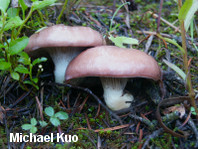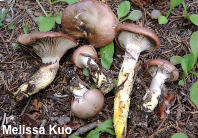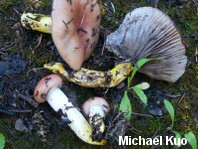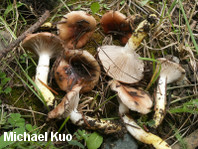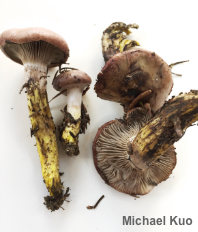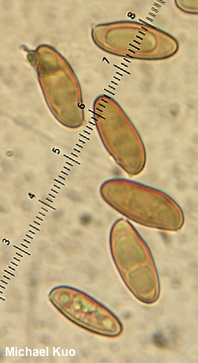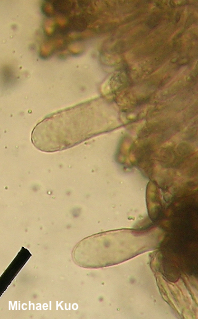| Major Groups > Gilled Mushrooms > Dark-Spored > Gomphidius > Gomphidius subroseus |

|
Gomphidius subroseus [ Basidiomycota > Boletales > Gomphidiaceae > Gomphidius . . . ] by Michael Kuo The slimy, pinkish cap, the gills that run down the stem, the "slime veil" sheathing the stem, the blackish spore print, and the yellowing stem base define Gomphidius subroseus, which is fairly widely distributed under conifers in North America—though it is much more common in the west under Douglas-fir. Collectors have often noted that Gomphidius subroseus is frequently found with Suillus lakei in the vicinity, and it was long thought that this was a coincidence enabled by the fact that both mushrooms were mycorrhizal with Douglas-fir. However, more recent research (see Olsson and collaborators 2000) suggests that species of Gomphidius can actually parasitize species of Suillus, penetrating the mycorrhizae already established between the Suillus and the tree, and robbing both organisms of nutrients. Description: Ecology: Mycorrhizal with conifers, especially Douglas-Fir; growing alone or scattered; widely distributed, but rare in eastern North America; more common in the Rocky Mountains and on the Pacific coast. The illustrated and described collections are from Colorado. Cap: 3–6 cm wide; convex, becoming planoconvex or slightly depressed; bald or finely appressed-fibrillose; slimy; rosy red to pinkish brown, sometimes somewhat mottled with brownish to olive shades. Gills: Running down the stem; close or almost distant; pale at first, becoming smoky gray; short-gills frequent. Stem: 3–9 cm long; 5–10 mm wide; more or less equal, or tapering to base; with a fibrillose veil that is typically poorly developed and hard to distinguish underneath the slime veil; at maturity slimy over the lower portion; sometimes adorned with a ring or ring zone that becomes blackened by spores; white above, bright yellow below; discoloring and bruising black. Flesh: White in cap; yellow in stem. Odor and Taste: Not distinctive. Chemical Reactions: KOH negative on cap surface. Spore Print: Purplish gray to black. Microscopic Features: Spores 15–20 x 5–8 µm; smooth; narrowly ellipsoid or nearly fusiform; dirty yellowish to brownish in KOH. Hymenial cystidia 40–110 x 5–17.5 µm; cylindric to narrowly fusoid; smooth or a little wrinkled or encrusted; hyaline to grayish or brownish-walled; thin-walled. Pileipellis an ixocutis of gelatinized, smooth elements 1–3 µm wide, hyaline in KOH. REFERENCES: Kauffman, 1925. (Miller, 1971; Smith, Smith & Weber, 1979; Thiers, 1985; Arora, 1986; States, 1990; Phillips, 1991/2005; Lincoff, 1992; Barron, 1999; Miller, 2003; McNeil, 2006; Miller & Miller, 2006; Trudell & Ammirati, 2009.) Herb. Kuo 08120304, 08130701. Herb. DBG RMNP 2008-019. This website contains no information about the edibility or toxicity of mushrooms. |
© MushroomExpert.Com |
|
Cite this page as: Kuo, M. (2020, July). Gomphidius subroseus. Retrieved from the MushroomExpert.Com Web site: http://www.mushroomexpert.com/gomphidius_subroseus.html |
